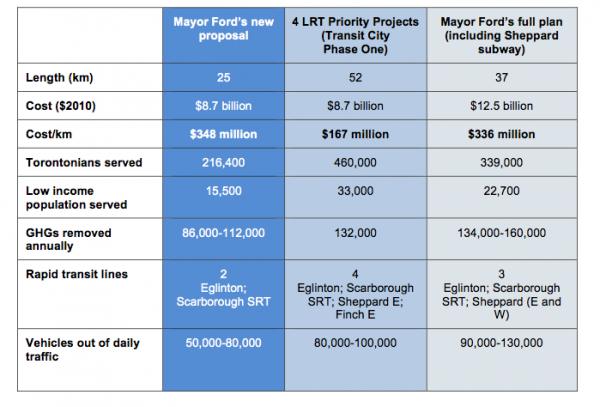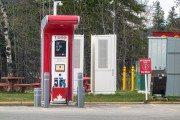Toronto Mayor Rob Ford claims on his Facebook page that the Pembina Institute’s 2011 analysis of Toronto transit options supports his case for a Sheppard Subway. Although we are pleased to see that the Mayor recognizes our work, some of his points require clarification.
While it’s true that a subway has the capacity to carry more riders than light rail transit (LRT) along Sheppard, our study shows that it would also cost about four times as much. Our study also shows that the population density along Sheppard is more suitable for an LRT; even based on projected growth it is unlikely that the full capacity of subway along Sheppard would be reached.
Furthermore, the entire LRT plan would have served more Torontonians per dollar invested than the mayor’s current plan as well as reducing more greenhouse gas emissions and removing more vehicles from our severely congested streets per dollar invested.
The table below compares the costs and benefits of the provincially- funded portion of the current plan (“Metrolinx-City plan”) to the four LRT priority projects (Phase One of Transit City) and Mayor Ford’s larger $12.4 billion transit plan that includes a Sheppard subway.



 When crunching the numbers from the table above on per dollar invested basis, comparing the mayor’s current plan with the former LRT proposal:
When crunching the numbers from the table above on per dollar invested basis, comparing the mayor’s current plan with the former LRT proposal:
- brings rapid transit to less than half as many Torontonians as the former LRT plan per dollar invested;
- serves 30 per cent fewer low-income residents despite costing 40 per cent more; and
- removes fewer vehicles from traffic congestion per dollar invested.
Mayor Ford’s current plan has additional shortcomings:
- it does not include Finch, which is currently the busiest bus route in Toronto;
- it leaves out the north-west region of Toronto, which has the highest low-income population and the worst access to rapid transit; and
- it leaves out a guaranteed rapid transit line for Sheppard, since it is no longer included in the provincial budget and the private financing strategy being pursued cannot guarantee success.
Our analysis shows that based on both cost per rider and cost per Torontonian served, a Sheppard subway is a costly investment,as is burying the full Eglinton Crosstown line. From our perspective, the funds required for these projects could be more effectively spent building transit where we need it most, such as along the Finch corridor.
_________________________________________________________________________________________________
Please note: All numbers and calculations in this blog are based on publicly available documents and data from Metrolinx and the Toronto Transit Commission. These documents are referenced in detail in the report Making Tracks to Torontonians (The Pembina Institute, 2011).





